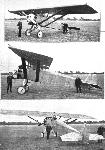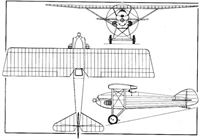Wibault Wib.7 и Wib.72
<...>
В конце 1919 года была организована фирма «Society des Avions Michel Wibault», а затем построены два прототипа: в 1921 году большой двухместный ночной бомбардировщик Wib.2 категории Bu.2, а в 1923 году - моноплан-парасоль Wib.3, истребитель категории C.1.
Построенный в 1924 году прототип истребителя Wib.7 (категория C.1) внешне походил на Wib.3, но был оснащен радиальным ПД Gnome-Rhone 9Ad мощностью 480 л.с. (358 кВт). Однако основной его «изюминкой» являлась цельнометаллическая конструкция каркаса, запатентованная Вибо. После развертывания серийного производства, в 1929 году, французские ВВС получили 60 истребителей Wib.72 с усиленными подкосами крыла. В 1927 году был построен прототип истребителя Wib.73 (категория C.1) с 450-сильным (336 кВт) ПД Lorraine 12Eb.
Планы по лицензионному выпуску этой машины в Польше не были реализованы, хотя в 1929-1930 годах компания PZL поставила польским ВВС три Wibault 7 с радиальными ПД Wright и 25 Wibault 72.
Wib.73 был продан только Парагваю, купившему семь самолетов. Вариант с усиленным фюзеляжем и посадочным крюком Wib.74 (построено 18) был поставлен ВМС Франции для эксплуатации на авианосце «Беарн». За ним последовало 18 Wib.75, оснащенных фотокамерами. Эти морские самолеты служили в составе Escadrille 7C1 и 7C2 до конца 1937 года.
Показать полностьюShow all
Flight, May 1923
A NEW FRENCH ALL-METAL AEROPLANE
The Michel Wibault 3 C.I.
GREAT efforts are being made in France with all-metal construction, and whether or not one agrees with the manner in which French engineers attack the problem, one must admit that they are very much in earnest, and that very considerable progress is being made. It is a somewhat curious fact that whereas in this country we are not allowed to use Duralumin for highly-stressed parts, both in Germany and in France this material is being extensively used, and, apparently, with no ill effects on the strength and life of machines. One cannot help wondering a little whether it is a case of "all being out of step except our John." Among the French designers who have long occupied themselves with metal construction is M. Michel Wibault, who exhibited a metal wing as long ago as the 1921 Paris Aero Show. Sketches of this wing were published in our issue of January 12, 1922. This wing, which, like the rest of the B.K. 2, was built by Pierre Levasseur, was, at that time, well ahead of the majority of other French-designed metal wings, being reasonably cheap to make and yet possessing a good strength/weight ratio. We have recently obtained particulars of the latest Wibault machine, which is also constructed mainly of Duralumin, although certain very highly-stressed fittings are made of steel.
This machine, the 3 C.I., is designed as a fast single-seater fighter for high altitude work, but if desired may be used for long-distance photographic reconnaissance. Among the desiderata aimed at by the designer are high aerodynamic efficiency, great manoeuvrability, maximum range of vision, good machine gun accessibility and a high factor of safety.
In weighing the various problems it was decided to make the machine of metal, all except the covering, which is ordinary doped fabric. The necessity for a good view resulted in a parasol monoplane arrangement, and the desire for good aerodynamic efficiency pointed to the cantilever wing. Since, however, a very large factor of safety was essential, it was decided that a small amount of external bracing would not affect the efficiency greatly, while it would enable the wing to be made very strong. Consequently the actual machine incorporates a fairly thick wing, raised above the fuselage, and braced on each side by one pair of struts. The factor of safety is claimed by the makers to be 19, and the wing is stated to have withstood a sand load of more than 50,000 lbs. The wing section used is one developed by M. Wibault. It has a flat bottom surface, and the leading edge is very much rounded. The depth is not extraordinary, as it was found that a wing of medium thickness with external struts gave better results than a thicker wing without struts. The maximum L/D of the wing is stated to be just under 20.
The wing of the Wibault 3 C.I. is built in two halves, the roots attaching to inverted V-struts from the fuselage, and the lift struts meeting the spars nearly half-way out to the tips. It might appear that this point is rather far outwards, but, on the other hand, probably the designer had in mind torsional stiffness rather than the direct bending stresses, which, after all, are fairly easy to take care of. There is little doubt that the breakage of the wings of the Dornier "Falke" at Madrid recently was the result of insufficient stiffness against torsion, as the wings are stated to have been seen by competent observers to "flutter" before they finally broke. The two tubes seen in the front elevation of the Wibault are not part of the wing structure, being aileron control tubes used to avoid the use of cables in the aileron control system. The wing spars are of the Duralumin box type, and the ribs are built up of Duralumin tubes, assembled by small Duralumin fittings pressed from the sheet. The ailerons, it will be seen, are very long, and of high aspect ratio.
No particulars are available relating to the fuselage construction beyond the fact that it is all-metal, with the exception of the covering. Even this is aluminium over the front portion, up to the cockpit. The 300 h.p. Hispano-Suiza engine is entirely cowled-in, and is equipped with a Rateau supercharger, which enables full power to be maintained up to an altitude of 15,000 ft. A Lamblin radiator is mounted on each side of the fuselage.
The undercarriage is usual type, but the arrangement of the rubber shock absorbers is such as to enable these to be removed without dismantling the axle.
The main characteristics of the Wibault 3 C.I. are as follows :- Span, 38 ft. 7 ins. Length o.a., 26 ft. 7 ins.; Chord, 7 ft. 5 ins. Wing area, 285 sq. ft. Weight of machine empty, 2,100 lbs. Weight of fuel, 500 lbs; Useful load, 485 lbs. Total loaded weight, 3,085 lbs. Wing loading, 10-8 lbs./sq. ft. Power loading, 10-3 lbs./h.p. Speed at 6,500 ft., 152 m.p.h. Speed at 16,500 ft., 174 m.p.h. Ceiling, 34,500 ft. Range at 16,500 ft., 530 miles. Landing speed, 50 m.p.h.
Показать полностьюShow all
Flight, December 1926
The Paris Aero Show 1926
WIBAULT
M. MICHEL WIBAULT is the great French specialist of all-metal aircraft construction whose name has now for several years past been associated with the production of military aeroplanes of the strut-braced parasol monoplane type. The novelty of many of his ideas has somewhat handicapped him in military circles until recently, when the sheer merit of his designs brilliantly asserted itself at the recent French competition for single-seater fighters, as a result of which a series of Wibault 7 C.1 fighters were ordered by the French Air Service. This type is also being constructed for the Chilian Air Service by Vickers, Ltd., under licence from M. Wibault.
It is this type of aeroplane which will be exhibited at the Wibault stand. The Wibault 7 C.1 is entirely built of duralumin, the fuselage being built up of angle sections and strips while the wings have duralumin tube spars and ribs of the same alloy. Both the wings and the fuselage are covered with sheet duralumin, which is applied in small strips and secured to the framework with a patented metal seam. This construction allows of rapid and easy repairs.
The landing gear is of the axle-less type with oleo-pneumatic shock-absorbers.
The engine is a 420 h.p. Gnome-Rhone Jupiter.
The performances, weights, etc., given hereafter include the full military equipment, namely, two wing guns firing over the propeller, two fuselage guns synchronised with the engine, 2,000 rounds of ammunition, oxygen inhalator, fire extinguisher, self-starter, electrical equipment, parachute, camera and signal apparatus.
The fine visibility and the low landing speed of this machine make it also a desirable type for photographic work as well as for night reconnaissance and fighting.
Specification of the Wibault 7 C.1 Fighter
Engine, 420 h.p. Gnome-Rhone Jupiter; span, 11-0 m.; length, 7-450 m.; height, 2-90 m.; wing chord, 2-10 m.; wing area, 22-2 sq. m.; weight, empty, 827 kg.; useful load, 352 kg.; fuel load, 265 kg.; load carried, 617 kg.; weight, loaded, 1,444 kg.; wing loading, 65-5 kg./sq. m.; power loading, 3-44 kg./h.p.; safety factor, 11-8.
Official Performances (S.T.Ae. Tests).
Altitude (m.) 0 1,000 2,000 3,000 4,000 5,000 6,000
Max. speed (km.p.h.) 222 222-5 222-6 223-2 223-2 221-4 217-7
Climb (m.-s.) 2-42 5-14 7-57 10-56 15-17 21-14
Climb to 7,000 m. in 29 min. 22 sec.; ceiling, 8,500 m.; low speed at 850 m. altitude, 104-2 km.p.h.; unstick run, 106 m.; landing run, 190 m.
The aircraft factory of Avions Michel Wibault at Billancourt (Seine) is at the present time exclusively engaged in production and development work for the French Army Air Service. They have, beside the production order for 7 C.1's, in course of construction a single-seater attack machine, type 13 C.1, with 400 h.p. Hispano-Suiza engine, and a type 12 C.2 two-seater fighter with 500 h.p. Hispano-Suiza engine. Other types recently produced include the 8 C.2 two-seater fighter (500 h.p. Hispano-Suiza), the 9 C.1 single-seater fighter (400 h.p. Hispano-Suiza), and the 10 G.R. long reconnaissance two-seater (420 h.p. Gnome-Rhone Jupiter), all of which have passed the S.T.Ae. tests.
Показать полностьюShow all














